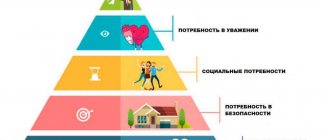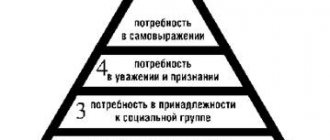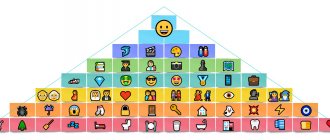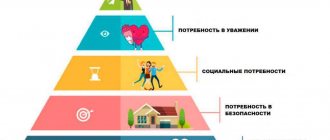Needs are the need experienced by a person for what is necessary for his normal functioning, to maintain the vital functions of the body and the development of personality.
A person needs certain conditions of existence. All human activities are aimed at satisfying their various needs.
A person’s needs may be different at different stages of his life, but some of them remain unchanged: these are basic physiological needs, without which the biological existence of a person is impossible. The structure of social and cultural needs is formed and changes throughout the life of an individual, turning him into a human personality, a subject of spiritual life. These needs contribute to the development of truly human qualities: reason, morality, the desire for truth, and creative activity for the benefit of society.
A person is able to limit his needs, relying on the conclusions of reason and focusing on social norms. Not always his needs can be fully satisfied. In addition, their satisfaction may contradict the moral norms of society and infringe on the interests of other people.
A person's needs are the basis for his interests. Interest is a form of conscious need, a person’s purposeful attitude towards an object, the desire to act in a certain way to achieve what he wants.
A person’s needs are also manifested in the motives of his activities. Unsatisfied needs have a motivating force, they cause a person’s activity, form and direct his aspirations towards a specific goal.
Manifestation of need
The need is manifested in the selective attitude of the individual to the existing conditions of the external world and is a dynamic and cyclical quantity. Primary needs relate to biological needs; in addition, a person feels the need to stay in society. The peculiarity of the need is such that it is an internal motivation and stimulus for activity, but at the same time work becomes a subject of necessity.
At the same time, doing something creates new needs, since certain funds and costs are needed to bring the plan to life.
Human needs from a psychological point of view
The process of satisfying a need is nothing more than a purposeful activity. At this moment, the person focuses all his attention on it: sets a goal, looks for means to achieve it, and takes specific actions.
Psychology studies human needs most thoroughly . After all, a person’s happiness and mental balance depend precisely on whether he knows how to satisfy his desires or not.
“Healers of the Soul” highlight several interesting features in this topic:
- A person's need can be realized, or maybe not.
In the first case, the person has the opportunity to satisfy it without hindrance. The second option is a field for psychologists to work on: for a long time, people may experience mental suffering (they are often somatized - manifested through bodily symptoms), but still not understand what they really want.
And if you don’t know what you want, then you have no idea how to get rid of discomfort and make yourself happy.
An unconscious craving for something is called attraction , a conscious one is called desire; - At the moment when the understanding comes of what you really want (objectification), gives rise to a motive.
Motive (motivation) is the driving force thanks to which we begin to do something. A girl wants to lose weight (goal), for this she begins to eat right, go to the gym (actions), and all because it is important for her to please the opposite sex (motive) in order to feel in demand (need);
- The more acute the need, the more negative emotions.
Therefore, know: if you are very irritated, it means that some of your needs are not being satisfied at the moment. The stronger the emotion, the stronger your desire for something. You need to listen to yourself and understand what you want: water, sex, relaxation, fame, or maybe you want attention from that handsome young man);
- It often happens that at one moment there are immediately two needs.
If one of them has a more pronounced relevance, then by setting priorities, a person will satisfy them one after another. For example, you came home from work, you are tired and very hungry. You may decide that sleep is more important and go to bed. Or do the same, but have a quick snack before doing it.
However, there are situations in which a person simply cannot make a choice and suffers from it. Remember the parable about Buridan's donkey? He died of hunger because he could not choose which of two piles of hay was more appetizing. This is roughly the same thing that happens to people.
A situation where needs are two equal piles of hay is called internal conflict , which can be resolved with the help of a psychologist.
Needs in society
A society in which human needs are not developed and reproduced is doomed to degradation. The needs of people in different eras correspond to the spirit of entrepreneurship and development, reflect dissatisfaction and despair, express collectivism, a common faith in future affairs, generalize people's aspirations and claims that need periodic satisfaction. The relationship between primary and secondary needs is formed not only in terms of social status, but under the influence of the accepted lifestyle, the level of spiritual development, and the diversity of social and psychological groups in society.
Without satisfying urgent needs, society cannot exist and reproduce social values at the level of historical and cultural standards. Urgent needs for movement, communication, and possession of information require society to develop transport, means of communication, and educational institutions. People care about satisfying primary and secondary needs.
Differences between needs and wants
Needs and desires are not the same thing. There are differences.
| Needs | Desires |
| 1. Needs are always constructive. Human needs indicate the importance and primacy of their satisfaction for the possibility of further functioning and life. 2. The basis of the need is always something important and deep. 3. Thanks to the satisfaction of needs, a person finds harmony with himself. | 1. They are destructive in nature. May harm personal development and life. So, drug addiction is a “wish”, not a need. 2. Other people can impose “wants.” 3. Desires may be superficial and not satisfy the true needs of a person. |
Let's try to figure it out with an example. Imagine that you live in your own apartment and dream of a summer house. You don't have enough money to buy a summer house, so you're angry. In this case, giving is a desire. But if you have nowhere to live, then buying any housing is satisfying a need.
Why is it necessary to distinguish between needs and desires? This is necessary for proper distribution of energy and resources. It also makes it possible to better understand yourself and others. Well, besides, seeing the differences, a person will be able to set priorities correctly.
To make the task easier, just honestly answer the following questions:
- Is it possible to do without this? A fashionable dress is a desire, but not a need. You can put it aside and buy it when there are enough opportunities for this.
- What will I get? The answer to this question will help you understand the nature of the origin of what you want.
- Will this purchase limit me? Desires should not interfere with the satisfaction of needs. Always prioritize.
Types of needs
Human needs are so diverse that to generalize them into different categories requires classification according to several criteria:
- Primary and secondary needs are divided in importance;
- according to the grouping of subjects, collective, individual, public and group are distinguished;
- according to the choice of direction, they are divided into ethical, material, aesthetic and spiritual;
- if possible, there are ideal and real needs;
- by area of activity, the desire to work, physical rest, communication and economic areas are distinguished;
- According to the method of satisfying needs, they are divided into economic, requiring limited material resources for production, and non-economic (need for air, sun, water).
A satisfied need ceases to motivate
Another interesting phenomenon is that if a need has already been satisfied, it often ceases to motivate a person. Almost all of us know this, but for some reason Maslow did not take this phenomenon into account in his theory. After all, the system of needs is also conditional in the sense that if a person has achieved what he wants, he does not rejoice at it for long, again falls into boredom, despondency, and looks for new supports for further growth.
We know from our own lives that it is enough to buy, study, build something - interest in it immediately disappears, the faster the more lively, active and ambitious the person is. But this is not reflected in Maslow’s pyramid.
Primary Needs
This category includes innate physiological needs, without which a person cannot physically exist. These include the desire to eat and drink, the need to breathe clean air, regular sleep, and satisfaction of sexual desires.
Primary needs exist at the genetic level, and secondary needs arise with increasing life experience.
Abraham Maslow's Hierarchical Theory of Needs
American psychologist A. Maslow created the hierarchical theory of needs. He arranged all human needs in ascending order, from lowest to highest. For clarity, these categories of needs can be arranged in the form of a pyramid. The main principle of this hierarchy: the needs of each next level become relevant when the needs of the previous level are satisfied.
At the base of the pyramid there are physiological needs (hunger, thirst), at the next level - the needs of self-preservation (safety, a sense of security), even higher - social needs (love, a sense of spiritual closeness, belonging to a group), at the next level - the needs for respect ( recognition, authority, social status), at the top of the pyramid - the need for self-affirmation (creativity, self-realization).
Ideal Needs
This group includes the desire to develop independently, manifested in the desire to receive new information, explore it and navigate in society. The need to study the surrounding reality leads to an awareness of one’s place in the modern world, knowledge of the meaning of life leads to an understanding of one’s purpose and existence. Intertwined with the ideal are primary needs and spiritual desires, which represent the desire for creative activity and awareness of beauty.
What is the meaning of Maslow's pyramid
If Maslow’s pyramid is considered, the human needs in it are stated rather conditionally, vaguely, the theory is sometimes far from practice. But it has a meaning and it is quite simple - looking at the picture of the pyramid, we must understand that a person is a complex being and there are things that concern him first, and there are things that can be put off until later.
By understanding what motivates people, you can effectively build communication and work process with them, find the right incentives for collaboration and increase the efficiency of employees.
Spiritual aspirations
Spiritual interests develop in a person in connection with the desire to enrich life experience, broaden his horizons, and develop creative abilities.
The growth of personal potential forces an individual not only to be interested in the culture of humanity, but also to care about representing the values of his own civilization. Spiritual aspirations presuppose an increase in psychological tension during emotional experiences, awareness of the value of the chosen ideological goal.
A person with spiritual interests improves his skills and strives for high results in the field of activity and creativity. An individual treats work not only as a means of enrichment, but learns his own personality through work. Spiritual, biological and social needs are closely intertwined. Unlike the animal world, in human society the primary need is for biological existence, but it gradually turns into a social one.
The nature of the human personality is multifaceted, hence the variety of types of needs. The manifestation of aspirations in various social and natural conditions makes their classification and division into groups difficult. Many researchers offer various distinctions, putting motivation at the forefront.
Difficulty in motivation based on needs
It is important to note that not all employees have a high need for achievement and independence. A manager must always be mindful of the element of chance. There is no one best way to motivate. What works for motivating some people may not work for others. Moreover, organizations by their nature make it difficult to apply theories of motivation that focus on individuals. Interdependence of work, lack of information about individual performance, and frequent changes in work tasks due to improvements in technology make motivation difficult.
When talking about motivation, the word reward has a broader meaning than just money or pleasure, with which the word is most often associated. Reward is anything that a person considers valuable to himself. But people's perceptions of value are specific, and so the valuation of rewards and their relative value vary.
A manager deals with two main types of rewards: intrinsic and extrinsic.
Intrinsic rewards arise from the work itself. For example, this is a sense of achievement, meaningfulness and significance of the work done, as well as a sense of self-worth. The friendships and interactions that arise from work are also considered intrinsic rewards. The easiest way to achieve intrinsic reward is to create the right working conditions and clearly define the task. Volvo, for example, eliminated several assembly lines at one of its pilot plants and replaced them with assembly teams to improve internal worker compensation.
Extrinsic rewards are the types of rewards that most often come to mind when you hear the word “reward.” Extrinsic rewards do not come from the job itself, but are provided by the organization. Examples of extrinsic rewards include salary, promotions, symbols of status and prestige, praise and recognition, and fringe benefits (extra time off, company cars, expenses, and insurance).
In order to determine how and in what proportion to use intrinsic and extrinsic rewards for motivational purposes, management must determine what the needs of its employees are. This is the goal of substantive theories of motivation.
Classification of needs of a different order
Primary human needs are divided into:
- physiological, which consists of the existence and reproduction of offspring, food, breathing, shelter, sleep and other needs of the body;
- existential needs, which are the desire to ensure comfort and safety of living, work to obtain benefits, and confidence in future life.
Secondary needs acquired during the course of life are divided into:
- social aspirations to gain connections in society, to have friendly and personal attachments, to take care of relatives, to gain attention, to participate in joint projects and activities;
- prestigious desires (to respect oneself, to gain recognition from others, to achieve success, high awards, to move up the career ladder);
- spiritual - the need to express oneself, to realize one’s creative potential.
Theory and practice
In theory, everything looks quite interesting. Maslow's coherent theory of needs is very logical; it really describes reality and nature well for most people around. But over time, there were many critics of this theory, since in practice it began to increasingly diverge from reality.
The theoretical calculations of A. Maslow began to be actively applied in practice. Here are just a few areas of activity where they were adopted:
- Psychology and sociology. Researchers began to look at society and typical human needs with greater understanding and began to see patterns in all this;
- Maslow's theory is applied in human resource management systems to increase employee motivation and increase their ability to work and efficiency;
- There are many tips on how you can use Maslow’s pyramid in marketing, where it allows you to attract attention and encourage people to make purchases and orders.
Also, the theory continues to interest theoretical researchers who are trying to clarify and supplement it to this day.
Classification of desires according to A. Maslow
If you find out that a person has a need for shelter, food and a healthy lifestyle, then you have identified a primary need. Need forces an individual to strive to obtain essential benefits or change an undesirable situation (disrespect, shame, loneliness, danger). The need is expressed in motivation, which, depending on the level of personal development, takes on a specific and definite form.
Primary needs include physiological needs, for example, procreation, the desire to drink water, breathe, etc. A person wants to protect himself and his loved ones from enemies, help them treat diseases, and protect them from poverty. The desire to get into a certain social group sends the researcher to another category - social needs. In addition to these aspirations, the individual feels a desire to be liked by others and demands respectful treatment.
Human needs are constantly changing; in the process of human evolution, motivation is gradually being revised. E. Engel's law states that the demand for low-quality food products decreases as income increases. At the same time, the demand for food products, which are required of increased quality while improving the standard of human life, is increasing.
Controversial sides of the pyramid and criticism
Psychologists of many directions actively criticize Maslow’s system, finding in it many discrepancies with real life and specific people. Here are the main statements of critics on this issue:
- History knows a lot of cases when the dissatisfaction of basic needs did not make a person more down-to-earth, but, on the contrary, stimulated him to act and create, write songs, develop, comprehend nature and God;
- Each person has their own level of satisfaction with things. One has enough of the meager lunch, another suffers from the inability to eat in the most expensive restaurant in the city;
- The inability to recognize Maslow’s theory as 100% working is also associated with the fact that many people show insatiable aspirations and cannot satisfy the most basic needs, wanting more and more.
Often brilliant people were poor, physically weak, unhappy and despised by society, but this did not prevent them from remaining in history.
Motive of behavior
The existence of needs is judged by a person’s deeds and behavior. Needs and aspirations are referred to as quantities that cannot be directly measured and observed. Researchers in the field of psychology have determined that certain needs motivate an individual to act. The feeling of need forces a person to act to satisfy needs.
Drive is defined as a lack of something that turns into a certain course of action and a person concentrates on achieving the result. The result in its final manifestation means a means to satisfy desire. If you achieve a certain goal, it may mean complete satisfaction, partial or incomplete. Then determine the ratio of primary and secondary needs and try to change the direction of the search, while leaving the motivation the same.
The amount of satisfaction obtained as a result of an activity leaves a mark on memory and determines the behavior of the individual in the future under similar circumstances. A person repeats those actions that caused the satisfaction of primary needs, and does not commit actions leading to failure to fulfill his plans. This law is called the law of result.
Managers in modern society model situations that allow people to feel satisfaction through behavior that benefits them. For example, a person in the process of production activity must imagine the completion of work in the form of a meaningful result. If the technological process is structured in such a way that the individual does not see the final result of the work, this will lead to the disappearance of interest in the activity, violation of discipline and absenteeism. This rule requires the administration to develop the production sector in such a way that technology does not conflict with human needs.
Primary and secondary needs [p.362]
PRIMARY NEEDS are physiological in nature and, as a rule, innate. Examples include the need for food, water, breathing, sleeping and sexual needs. SECONDARY NEEDS are psychological in nature. For example, the needs for success, respect, affection, power and the need to belong to someone or something. Primary needs are genetically determined, while secondary needs are usually recognized through experience. Because people have different backgrounds, people's secondary needs vary more than their primary needs. [p.363]
The set of needs of each individual depends on his individual qualities. Needs are considered from various angles, such as biological, industrial, economic, social, etc. The primary life needs of a person are not unlimited. Along with them, there are secondary needs of a higher level: social, cultural and spiritual. Needs are not a static category, but a dynamic, satisfied need ensures the development of the individual and society as a whole, thereby raising them to a new level, to new higher needs. [p.9]
Needs are classified according to certain criteria. Thus, a distinction is made between primary and secondary needs. Primary needs are those needs that a person experiences in any situation because their satisfaction is vital (for example, food, water, clothing, etc.). Secondary needs are those that arise with the development of civilization (for example, refrigerators, televisions, cars). In addition, a distinction is made between individual and social needs. Individual are those needs that a person experiences as an individual. People feel social needs as members of society. For example, food and water are individual needs, while the needs are for social order, justice, etc. —- social. Typically, a person himself ensures that his individual needs are met by buying, for example, food and clothing from other people. At the same time, the government or other public organizations (parliament, city council, etc.) ensure satisfaction of the public [p.52]
American researcher A. Maslow divided the entire set of needs into two groups: primary and secondary needs. In turn, Maslow divided the primary needs into physiological, the need for safety and security. [p.65]
Secondary needs are psychological in nature (needs for success, respect, affection, power, belonging to someone or something). [p.112]
Maslow arranged all these needs in the form of a strict hierarchical structure (pyramid). In this case, the needs of the first and second levels are classified as primary needs, and the subsequent ones (third - fifth level) are classified as secondary needs. Maslow's hierarchy of needs is shown in Fig. 4.9. [p.115]
Needs and requirements. A person experiences need when he feels physiologically or psychologically lacking something. In accordance with the cultural structure, a need can acquire the character of a specific need. Most psychologists agree that needs can in principle be classified as primary needs, often called needs, and secondary needs, or simply needs. [p.211]
Secondary needs by their nature are related to the cultural structure and are recognized in accordance with life experience. Among them, socio-psychological needs occupy a prominent place. For example, the needs for success, respect, affection, power and the need to belong to someone or something. People have different life experiences, so people's secondary needs vary greatly. [p.211]
Secondary needs are psychological in nature. These are, for example, the needs for respect, success, affection, wealth, power, etc. [p.82]
Needs are usually divided into primary, which satisfy vital human needs (food, clothing, etc.), and secondary, which include all other needs (for example, leisure needs, cinema, theater, sports, etc.). Primary needs cannot be replaced by one another, but secondary needs can. The division into primary and secondary needs is historically arbitrary; the relationship between them changes with the development of society. [p.14]
Secondary needs arise as life experience is gained. [p.579]
Primary needs are physiological in nature and, as a rule, innate. These are the needs for food, water, breathing, surrender, etc. Secondary needs are psychological in nature. For example, the need for success, respect, affection, power, the need to belong to someone or something. Primary needs are genetically determined, secondary needs are recognized through life experience. Because people have different backgrounds, people's secondary needs vary more than their primary needs. [p.195]
The substantive concept of motivation is based on an awareness of the primary and secondary needs of a person, which serve as the motive for his actions. A person wants to satisfy his needs, and if conditions are provided for the realization of his needs, then a favorable environment is created for stimulating a person’s motivation and behavior. For effective motivation, detailed knowledge of human needs is necessary, since each person has an individual system of needs. But the nature of a person’s behavior is determined not only by his needs, but also by interests, which are by no means identical to needs. Interests reflect the desire to satisfy needs in a certain environment. Interests - awareness of people's needs and the conditions for their satisfaction, assessment of the real possibility of meeting needs. A person may have some needs, but at the same time he may [p.196]
All employee needs can be represented in the form of a certain structure. Primary ones are the basis for the formation of secondary needs of a higher order, the achievement of which makes it possible to satisfy and expand the range of primary needs to a greater extent. [p.118]
There are primary and secondary needs. The primary ones are genetically based, and the secondary ones are developed in the course of cognition and experience. [p.262]
Secondary needs are associated with a person’s psychological mood: the need for success, respect, power, and communication. The use of secondary needs in the motivation system as incentives to intensify the activities of organization members in achieving common goals is a more complex task than material incentives. However [p.273]
For industrial enterprises, the primary need should be decomposed into secondary components, such as components, parts and raw materials. When calculating the secondary requirement, the primary requirement is assumed to be given, including information on the volume and timing of the specification or information on the applicability of possible additional supplies of the amount of materials at the disposal of the enterprise. Therefore, to determine secondary demand, as a rule, deterministic calculation methods are used. If this method of establishing the need is not possible due to the lack of specifications or the insignificant need for materials, then it is predicted using data on the consumption of raw materials and materials. [p.357]
Material support based on planned targets. This method is based on a deterministic calculation of material requirements. In this case, it is assumed that the primary need for a certain period, the structure of products in the form of specifications, which makes it possible to determine the secondary need, and possible additional need, are known. When providing materials based on planned assignments, the order size is determined based on the net requirement, taking into account the planned receipt and availability of materials in the warehouse. The procedure for such calculation is presented in table. 13.2. [p.359]
Primary requirement 2. Secondary requirement 3. Additional requirement 4. Total gross requirement 5. Warehouse stock 6. Intended stock 7. Planned receipt 8. On hand stock 9. Shop floor stock 10. Net demand (1) + (2) +( 3) (5) - (6) + (7) (4) - (8) - (9) [p.360]
Methods of satisfying the needs of higher levels (secondary needs) [p.166]
It has been established that, as a rule, a higher-level need is satisfied after a lower-level need is satisfied. Therefore, A. Maslow based the pyramid of the hierarchy of needs on physiological needs, i.e. the need for food, water, the need to breathe, sleep and love, which are genetically inherent in a person. Secondary needs are psychological in nature and are recognized through experience. These include the need for involvement in a business or someone, the need for personal achievement and self-esteem, recognition, as well as the realization of one’s potential and growth as an individual. [p.497]
Personnel motivation is inextricably linked with needs, the satisfaction of which serves as a motive for action. Personnel motivation is determined by a wide range of needs, and managers at various levels, in order to strengthen the motivation of a specific employee, must give him the opportunity to satisfy them. By taking appropriate actions, managers contribute to the achievement of the goals of the entire organization. When the standard of living is low, managers can reward subordinates almost exclusively with economic incentives. With high earnings and a sufficient level of social benefits, spiritual needs come first; accordingly, staff motivation occurs primarily through the satisfaction of secondary needs. Having expended some effort, the employee expects that the result will lead to the satisfaction of his needs. By showing initiative and a creative approach, he believes that, in addition to material rewards, his prestige, the respect of the team, and the degree of his self-expression will increase. If the connection between the effort expended [p.391]
Secondary demand is the need for products that are to be manufactured as part of the production program, but contracts for the supply of which have not yet been concluded. [p.52]
Define the concept of secondary need [p.80]
There is still no one universally accepted identification of needs. However, most psychologists agree that needs, in principle, can be classified into primary and secondary. Back in the 40s. XX century scientist A. Maslow [35] developed the so-called hierarchy of needs and pointed out that the listed primary human needs (for food, clothing, shelter from dangers or enemies, the need to provide living conditions for one’s family) are genetically embedded in him and are leading in his behavior . Secondary needs arise and are usually recognized with experience. A. Maslow identified as secondary needs the subject’s desire to provide for [p.33]
Secondary needs are developed in the course of cognition and gaining life experience, i.e. are psychological in nature. These are the needs for affection, respect, success, power. [p.38]
Is it possible to establish the relationship and interdependence between primary and secondary needs, material and spiritual needs. [p.14]
Secondary - psychological (for example, the needs for success, respect, affection, power, belonging to someone or something). Primary needs are genetically determined, while secondary needs are usually recognized through experience. Because people have different experiences, their secondary needs vary more than their primary needs. [p.21]
Secondary needs include social needs, sometimes called affiliation needs, social interaction, affection and support, esteem and self-esteem, respect from others, self-expression, fulfillment of potential, and personal growth. [p.66]
McClelland's theory of needs is also associated with the formulation of different levels. But McClelland focuses on the needs of only the highest levels (secondary needs according to Maslow), formulating them as the need for power, the need for success and the need for belonging. [p.116]
The basis of human life is the satisfaction of basic (basic) needs. Most psychologists are inclined to believe that primary and secondary needs can be distinguished. Primary ones, as a rule, are innate and include the physiological needs of the body for food, water, breathing, rest, etc. Such needs are genetically inherent in a person. Unlike primary needs, secondary needs are psychological and are usually realized with the acquisition of social experience. Considering that different people have different acquired social experiences, their secondary needs are also different. This is, for example, the need for respect, affection, wealth, power, and belonging to a certain social environment. In addition, a person strives to satisfy spiritual needs. These usually include the needs to determine the meaning of life, understand other people, and determine a person’s place in the social environment. The Austrian scientist W. Frankl considered the need for meaning in life as the most important in the structure of personality, influencing the life of a person as a whole, including his work activity. According to V. Frankl, dissatisfaction with the need for the meaning of life, which a person cannot always realize and formulate, often leads to the emergence of existential frustration. The satisfaction of this need is directly dependent on the personal characteristics of a person and his upbringing. In a number of cases, dissatisfaction with the need for meaning in life can take on ugly forms of striving for wealth, power, etc. [p.105]
Secondary needs are satisfied to a greater extent with the help of moral methods of encouragement, which include [p.171]
D. McClelland. Without denying the significance of previous theories and their conclusions about the importance of biological and other basic needs in motivating the behavior of workers, McClelland tried to identify the most important among secondary needs, which are actualized under the condition of sufficient material security. He argues that every organization provides opportunities for the employee to fulfill the three higher-level needs of power, success and belonging. On their basis, a fourth need arises, namely the need to avoid troubles, i.e. obstacles or opposition to the realization of the three named needs, for example, situations that do not allow success, that can deprive a person of power or group recognition. All employees experience some level of need for success, power, and belonging. However, in different people these needs are expressed differently or exist in certain combinations. How they combine depends, in addition to natural qualities, on the individual's personal experience, situation and culture. [p.193]
Primary need is defined as the need for products for which production and supply contracts have already been concluded, that is, for products whose release has priority. Secondary demand is the need for products that are to be manufactured as part of the production program, but contracts for the supply of which have not yet been concluded. Tertiary need is the need for the production program for auxiliary materials for production purposes. [p.60]
The starting point of any economic activity is the natural human need for goods. Humanity is driven by the impulse to satisfy primary needs, which in turn gives rise to the desire to satisfy secondary needs. But completely unconsciously, a person is guided by the motive of preserving labor energy 22. The commonality in human motives for economic activity does not exclude the presence of certain features. Culture, national mentality, and the dominant values of a social community are of sustainable importance for the development and success of economic activity. As a specific way of human activity, culture influences, and perhaps strictly determines and limits, the strategy and tactics of human social and economic actions. In accordance with the diversity of cultural programs ... the spirit governing economic entities can be deeply different and has long been deeply [p.19]
Advantages and disadvantages
Maslow's pyramid is valuable for studying large masses of people when there is no need to look closely at individuality. If we talk about its pros and cons, we can highlight the following:
- Pros. The ability to understand large masses of people, the applicability of theory to work in large teams, the ability to explain the behavior of individual people quite accurately, and have leverage over them. Also, thanks to theory, you can better understand yourself;
- Of the minuses: A. Maslow could not thoroughly describe each individual with his theory, take into account the variability of character, inconstancy, the presence of geniuses, dependencies on certain things. Many people behave differently and do not have the priorities that they should have, if assessed from the point of view of Maslow's theory.
Many psychologists believe that the pyramid is already outdated and today, when most people do not worry about low needs, it does not reflect reality.










